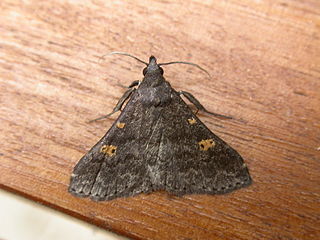
Naarda is a large genus of erebid moths currently encompassing 108 species. Initially identified by Francis Walker in 1866, it is in the family Erebidae. Somewhat ruddy in appearance, this genus is distinguishable for its generally slender thorax and abdomen, and straight, porrect labial palpi. Most species are a light tan color, but shading can reach as deep as a charcoal, with muddy yellow, conspicuous reniform, orbicular stigmata featured on the forewings, sometimes reflected bilaterally superior.

Brahmaea wallichii, also known as the owl moth, is a moth from the family Brahmaeidae, the Brahmin moths, and one of its largest species. It is found in the north of India, Nepal, Bhutan, Myanmar, China, Taiwan, and Japan. The owl moth is nocturnal. The wingspan is about 90–160 millimetres.

Apithecia is a monotypic moth genus in the family Geometridae described by Prout in 1914. Its only species, Apithecia viridata, described by Frederic Moore in 1868, is found in India, Nepal, Bhutan, China and Taiwan.

Comostola is a genus of moths in the family Geometridae erected by Edward Meyrick in 1888. They are found primarily in Asia and Australia.

Alcis is a genus of moths in the family Geometridae described by John Curtis in 1826.

Herochroma is a genus of moths in the family Geometridae. The genus was described by Charles Swinhoe in 1893.
Nadagara is a genus of moths in the family Geometridae first described by Francis Walker in 1861.
Palpoctenidia is a monotypic moth genus in the family Geometridae described by Prout in 1930. Its only species, Palpoctenidia phoenicosoma, was first described by Swinhoe in 1895. It is found in China, Japan and India.

Pingasa is a genus of moths in the family Geometridae first described by Frederic Moore in 1887.
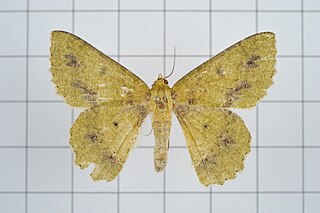
Herochroma cristata is a species of moth of the family Geometridae first described by William Warren in 1905. It is found in China, Taiwan, north-eastern India, Bhutan, Nepal, Thailand, northern Vietnam and Indonesia.
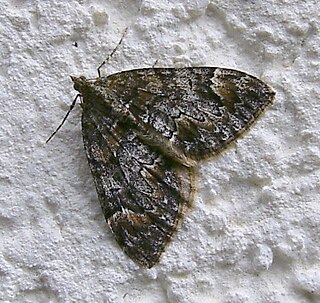
Dysstroma citrata, the dark marbled carpet or northern marbled carpet, is a moth of the family Geometridae. The species was first described by Carl Linnaeus in 1761. It is found across the Holarctic ecozone and has been reported from India.

Asthenini is a tribe of geometer moths under subfamily Larentiinae first described by Warren in 1893. The tribe has been combined with Eupitheciini in the past, most notably by Jeremy Daniel Holloway in his work The Moths of Borneo.
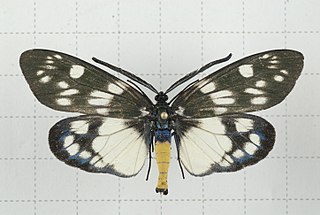
Eterusia aedea, the red slug caterpillar, is a species of moth in the family Zygaenidae. It was described by Carl Linnaeus in his 1763 Centuria Insectorum. It is found in Sri Lanka, India, Nepal, Taiwan, Japan and China.
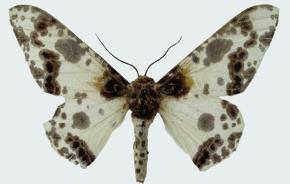
Biston panterinaria is a moth of the family Geometridae. It is found in China, India, Nepal, Sikkim, Vietnam and Thailand.

Cyclidia substigmaria is a moth of the family Drepanidae described by Jacob Hübner in 1831. It is found in Taiwan, China, India and Japan.

Obeidia lucifera is a moth of the family Geometridae first described by Charles Swinhoe in 1893. It is found in Taiwan, India, China and Nepal.

Pogonopygia pavida is a species of moth of the family Geometridae. It is found in the Himalaya, Taiwan, Japan, Indonesia and Peninsular Malaysia.

Tanaorhinus kina is a species of moth of the family Geometridae first described by Charles Swinhoe in 1893. It is found in Asia, including India, Bhutan and Taiwan.

Celenna festivaria is a moth of the family Geometridae first described by Johan Christian Fabricius in 1794. It is found in India, Sri Lanka, Myanmar, Borneo, Java Taiwan, the Ryukyu Islands and Luzon in the Philippines.
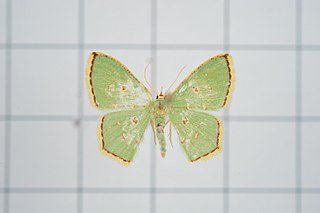
Comostola subtiliaria is a moth of the family Geometridae first described by Otto Vasilievich Bremer in 1864. It is a widespread species which is found in Korea and adjacent parts of Siberia, Japan, Borneo, Sumatra, India, South China, Taiwan, Borneo, Sumatra, and Sri Lanka.

















